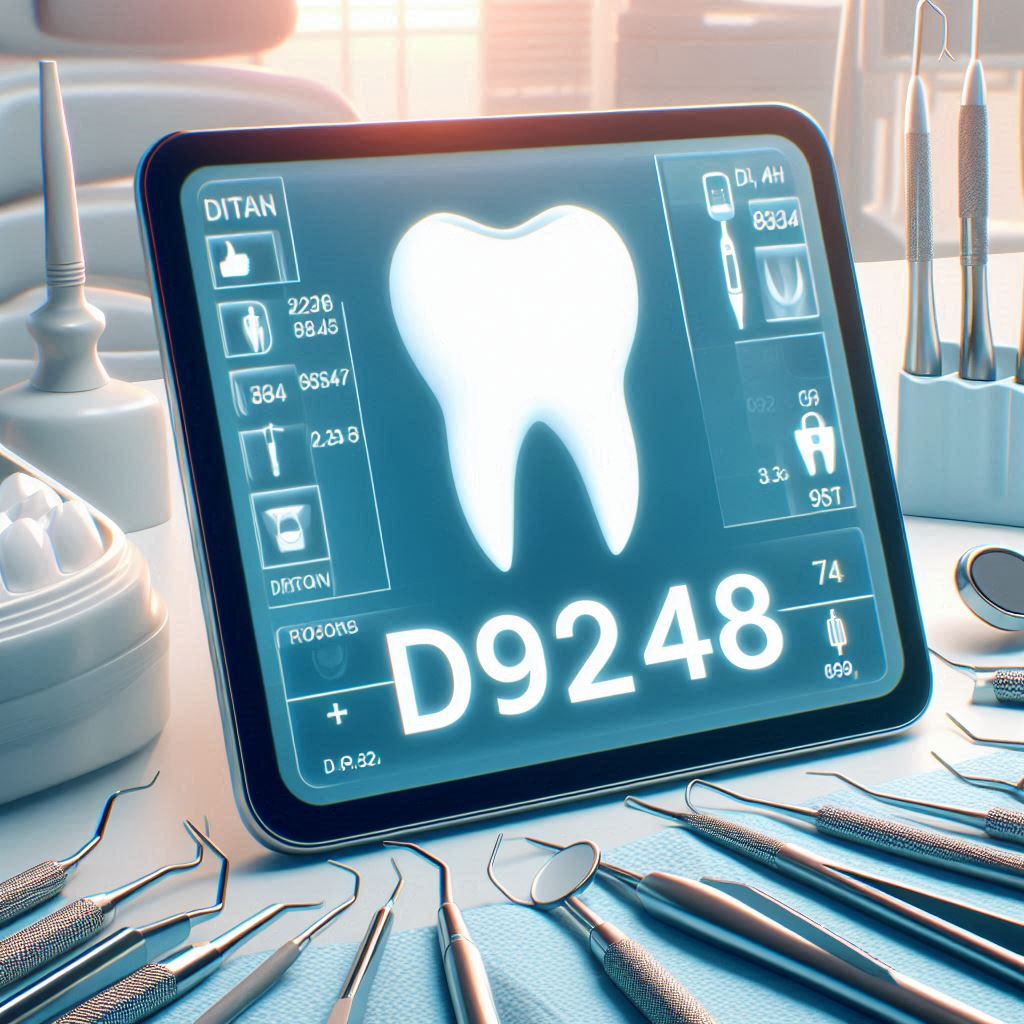D9248 Dental Code: Non-Intravenous Conscious Sedation
The D9248 dental code, as defined by the American Dental Association (ADA), refers to non-intravenous conscious sedation administered during dental procedures. Unlike deep sedation or general anesthesia, this method allows patients to remain responsive while reducing anxiety and discomfort.
Sedation dentistry has revolutionized patient care, particularly for those with dental phobia, special needs, or extensive treatment requirements. The D9248 code ensures standardized billing and documentation for oral, inhalation, or intramuscular sedation techniques.
This article provides an in-depth exploration of D9248, covering its clinical applications, safety protocols, insurance implications, and best practices for dental professionals.

2. Understanding Conscious Sedation in Dentistry
Conscious sedation is a minimally depressed level of consciousness where patients:
- Retain the ability to breathe independently.
- Respond appropriately to verbal commands.
- Experience reduced pain and anxiety perception.
Levels of Sedation
| Sedation Level | Responsiveness | Breathing Control | Memory |
|---|---|---|---|
| Minimal Sedation | Normal response | Unaffected | Vague recall |
| Moderate Sedation | Purposeful response | Adequate | Partial amnesia |
| Deep Sedation | Arousable with stimulation | May need assistance | No memory |
| General Anesthesia | Unresponsive | Requires support | No memory |
D9248 applies to minimal to moderate sedation achieved without intravenous (IV) access.
3. Types of Sedation Covered Under D9248
A. Oral Sedation (Enteral)
- Common Medications: Diazepam, Triazolam, Lorazepam.
- Advantages: Easy administration, no needles required.
- Disadvantages: Variable absorption rates.
B. Inhalation Sedation (Nitrous Oxide)
- Commonly Known As: “Laughing gas.”
- Advantages: Rapid onset, adjustable depth.
- Disadvantages: Requires specialized equipment.
C. Intramuscular (IM) Sedation
- Common Medications: Midazolam, Ketamine.
- Advantages: Faster than oral sedation.
- Disadvantages: Invasive, potential for discomfort.
4. Indications for Using D9248
D9248 is ideal for:
✔ Patients with dental anxiety or phobia.
✔ Lengthy procedures (e.g., multiple extractions, implants).
✔ Special needs patients (e.g., autism, Parkinson’s).
✔ Gag reflex sensitivity.
5. Contraindications and Risks
Contraindications:
- Severe respiratory conditions.
- Pregnancy (first trimester).
- Allergy to sedative agents.
Potential Risks:
- Over-sedation (rare with non-IV methods).
- Nausea/vomiting (especially with nitrous oxide).
- Hypotension or dizziness.
Proper patient screening (medical history, vitals) minimizes complications.
6. Step-by-Step Procedure for Administering Non-IV Sedation
- Pre-Sedation Assessment:
- Review medical history.
- Obtain informed consent.
- Administration:
- Oral: Pill taken 30-60 mins before procedure.
- Inhalation: Mask placed, adjusted per patient response.
- Monitoring:
- Continuous pulse oximetry.
- Verbal responsiveness checks.
- Recovery:
- Observe until stable (typically 30-60 mins).
- Provide post-op instructions (no driving, rest advised).
7. Comparison with Other Sedation Codes
| Code | Type | Route | Depth |
|---|---|---|---|
| D9241 | IV Sedation | Intravenous | Moderate-Deep |
| D9243 | General Anesthesia | IV/Inhalation | Unconscious |
| D9246 | Non-Enteral Sedation (IM) | Intramuscular | Moderate |
| D9248 | Non-IV Conscious Sedation | Oral/Inhalation/IM | Minimal-Moderate |
8. Insurance and Reimbursement for D9248
- Coverage Varies: Some insurers classify D9248 as medically necessary, while others consider it elective.
- Documentation Required:
- Justification for sedation.
- Patient’s anxiety level or medical need.
9. Legal and Ethical Considerations
- Licensing: Dentists must complete sedation certification courses.
- Informed Consent: Patients must understand risks/benefits.
- Malpractice Risks: Improper monitoring can lead to legal action.
10. Patient Preparation and Post-Sedation Care
Before Sedation:
- Fasting (2 hrs for liquids, 6 hrs for solids).
- Arrange transportation.
After Sedation:
- No alcohol for 24 hours.
- Avoid strenuous activity.
11. Common Medications Used in Non-IV Sedation
| Drug | Class | Onset | Duration |
|---|---|---|---|
| Diazepam | Benzodiazepine | 30-60 min | 4-6 hrs |
| Nitrous Oxide | Inhalation Gas | 2-5 min | Wears off quickly |
| Midazolam | Benzodiazepine (IM) | 10-15 min | 1-2 hrs |
12. Case Studies and Clinical Applications
Case Study 1: Dental Phobia Patient
- Procedure: Full-mouth restoration.
- Sedation Method: Oral Diazepam (10 mg).
- Outcome: Successful treatment with no anxiety recall.
Case Study 2: Pediatric Patient with Autism
- Procedure: Cavity fillings.
- Sedation Method: Nitrous Oxide (30%).
- Outcome: Cooperative behavior, minimal distress.
13. FAQs on D9248 Dental Code
Q1: Is D9248 sedation safe for children?
- Yes, when administered by a trained professional.
Q2: How much does D9248 sedation cost?
- Typically 100−100−400, depending on duration and medication.
Q3: Can I drive after non-IV sedation?
- No, arrange a ride home.
14. Conclusion
The D9248 dental code is essential for non-IV conscious sedation, improving patient comfort in dental care. Proper training, patient selection, and adherence to guidelines ensure safety and efficacy. By understanding its applications, risks, and billing protocols, dental professionals can optimize sedation dentistry outcomes.


